

RECAP
(Nov-2000)
 THE DIRECTION OF LIGHT
THE DIRECTION OF LIGHT
CHAPTER
34
![]() INDEX
TO OTHER PAGES
INDEX
TO OTHER PAGES
That haze which appears on a roadbed giving the illusion as if the roadbed were wet seems to be a simple phenomenon. But to explain the how and why is anything but simple. For even as a blade of grass growing out of the ground may seem simple for cells to multiply, yet such shall hardly be the answer.
For the roadbed - the light bends or is re-directed for the layer of warmer
air upon it as compared to the cooler air a bit further from the roadbed.
For as much as this answer may be correct it is also elementary and does not define the how and why in any real or deeper terms. If therefore we could understand these we would know all of nature, to know the very nature of light and how it goes about.
That knowledge therefore
would give us as much more understanding as light is from darkness. And the same
goes for a definition of the how and why of a blade of grass to come forth out
of the ground.
If we know the why in the light for the difference in temperature of the layers of air, how then is this accomplished in this minute section or distance in the air for an entity that travels at the speed of three hundred thousand kilometers per second?
We can divert the path of a bullet when it moves at one inch per second, but attempt to divert its path at over five thousand inches per second, which in effect is but a snails pace compared to that of light.
We in our conceptions are battling with the laws of nature such as that for every action there is an equal reaction. Such as when a one-pound force is required to divert a moving object in its path - that we must apply and consequently find a one-pound force.
And looking at that layer of air above the roadbed there is hardly
anything in the air to present such a phenomena to bind us to that law,
especially since the redirection of the light is literally and factually
instantaneous. And that alone does
not comply or fall in with these laws of nature -in what we might say “one for
the other.”
So “how” does the light redirect itself, or may it be redirected? For these are two different things to redirect itself, or to be redirected, to come of itself or to be forced into. The answer to that question as we shall see, or we already may know from my previous words on this subject – is both. But before we embark upon it let us reiterate the ground rules, or familiarize ourselves with what is factual in the way of light.
Light and the direction in which it will travel as also its relative velocity, is at all times duly “dependent” upon the media, or as I might coin to say, on the grains (atoms) of the media. This in turn bears upon the density, as to how compacted these grains are, and their mode of travel.
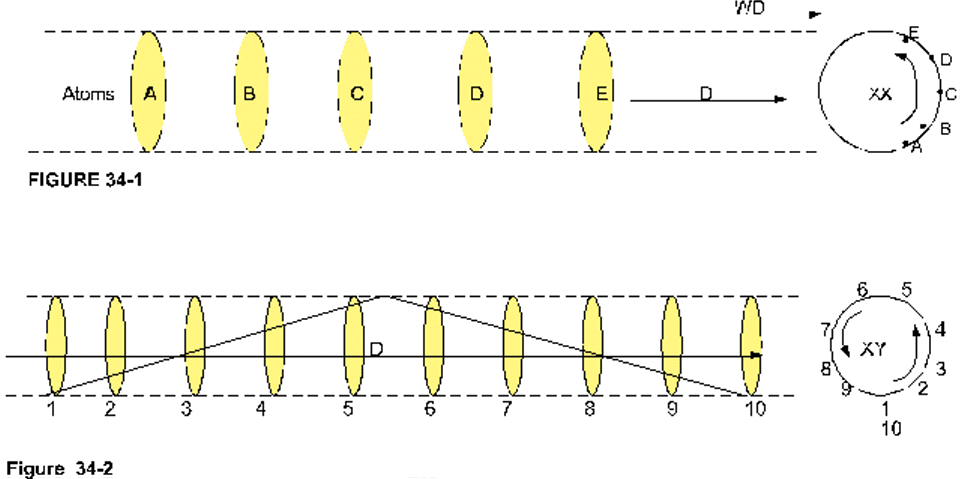
. When looking at Figure 34-1-A the line WD (Wave Direction) passing diagonal over the atoms from atom A to atom E is less than half of a single wavelength as further demonstrated by the circular presentation XX.
Which
brings us to another one of our ground rules - that light passes along the
perimeters of the atoms, and never at any time invades the interiors thereof.
For when it does invade the interior of the atom it will cease to exist.
This in effect is actually a frivolous statement since the application of light entering the atom does not exist. The phenomena however does exist in the molecular level where the light enters the so called interior of a group of atoms in a molecular bond whereby some, or all but one specific wavelength may pass through.
This in turn presents us with the color of things, such as the green color of a leaf. Here the light instead of passing through - was arrested by what I might coin to say the interior of the atomic group, the molecule as it is called.
As therefore each
different molecule will arrest or not arrest different wavelengths, those that
are again projected from it serve us with what we call the color thereof.
A full wavelength over the space of ten atoms is then represented by Figure 34-2. Here in the XY we note that the wave follows a counter clockwise rotation as it moves forward over the space of these ten atoms.
The direction of this wave in both figures 34-1 and 2 is then according to arrow D. which in effect is a straight line through space, or at least so we entertain ourselves the line to be.
And while
for all practical purposes this may indeed be so for the minute distance of a
single wavelet in that part of space, the same is not so absolute when the line
of travel is looked at over some distance.
(Figure 34-3)
When for example we take a perfectly straight glass rod laid out upon the earth North to South and we pass a beam of light through it. We might then acclaim that the light passed by a perfectly straight line. And indeed it did as far as the glass rod is concerned, but the same is not true for a line through space.
Since quite obviously while the light passed through the tube, the earth simultaneously moved in an Easterly direction. Meaning, the earth by its movement brought the end of the tube at a different place in space from the instant that the light started at the beginning thereof.
Wherefore as far as space is concerned (space being reckoned as a fixed
entity) the path of the light – in space – is most commonly by a slight
curvature.
When atoms A through E Figures 34-1 & 34-2 hold an equal spacing, the overall directional movement (D) of the light does not change. But when the wavelength passes from a cooler to a warmer area as in figure 3, the wave having passed atom D was not able to find atom E in the same place as before – but further down the line.
Accordingly, it had to readjust or shift its line of movement from WD
to WD2 in order to make its
essential contact upon atom E.
This in turn shifted line D to
D2.
The same may be demonstrated by figure 34-4 only in reverse, the wave passing from a lesser density to a greater density. In this case atom 4 has become atom 4a. The line of the wave here is noted as W, and its projection in an unchanging density would be WL.
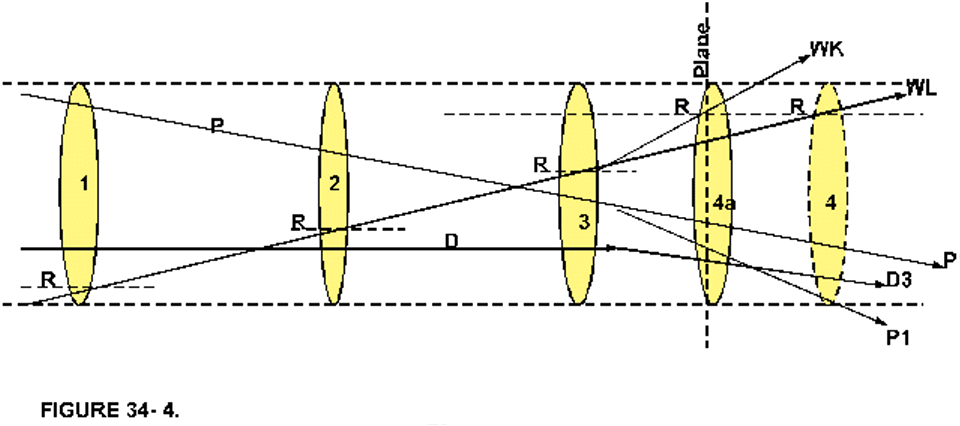
The points on the circumference of the atoms where this line passes are
noted R for atoms
1 through 4. Seeing thus how 4R has become 4aR –
if the wave-line is to come upon that particular point, it is bound to change
its direction to WK instead of WL.
Why however should it seek point R upon atom 4a and not rather point S to simply continue its journey on a different part of the circumference of the atom? That question now may indeed be intriguing.
We could say that the atoms draws the line. And there is a partial truth in that. But it is equally true that the line follows its given or initiated path upon any part of the circumference of the atom that comes in line therewith.
And so obviously there is more to it than this. We can't escape the fact
that if the line did proceed to WL
and not WK – how do we claim the waves of light to be susceptible to
the media? For in that case there would never be a red or blue shift of the
wave, nor therefore any change in the relative velocity of the light.
The “facts” as I so stated are deeply seated in the apprehension of the whole of nature. We are bound to consider the whole of the picture and not allow ourselves to be bogged down on a single coordinate that for its simplicity serve us with sight deception. Foremost, light in its wave-like forthcoming is not and cannot be apart of the physical media.
And
the physical media in its very being cannot be apart from what we apprehend as
waves or lines of movement, the EM spectrum if you will.
A length of a wave therefore which for its initiation may be given a
definite length as also a direction thereof, is nevertheless bound both for its
length and the direction thereof to the atomic grid. This in the same means in
and of the density thereof.
And to serve us with more examples so as to enhance our understanding in the nature of light let us refer to figures 34-5. The dots represent atoms, and the lines are the directional lines (D) of the wavelengths. With no change in density at figure 34-5A it is irrelevant from which direction the light proceeds over these atoms.
They
will at all times follow a straight line and connect or contact upon the atoms
at whatever part of their circumference that suits the line in its given
momentum.
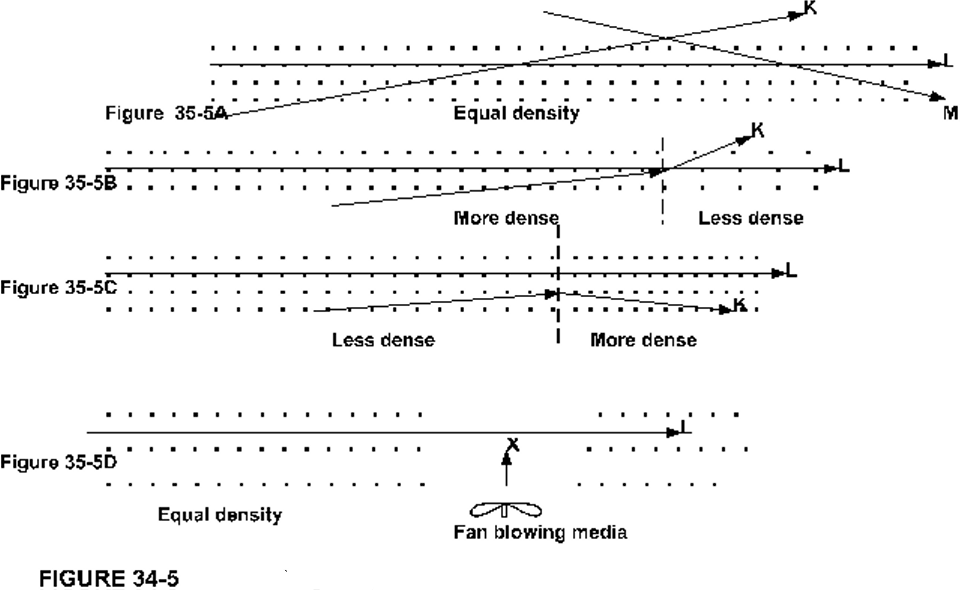
At figure 34-5B we have a change in the density, like unto the layer or warmer air just above a roadbed. In this case the line K which arrives at some angle to the plane of the less dense area is shifted to the left, or away from its angle of origin. Whereas in figure 34-5C the same line coming upon the plane of a more dense area the line is shifted to the right, or into its angle of origin.
Line
L however of both figures
34-5B and 5C which does not arrive at the plane of the change in density at some
angle, but rather straight, will not be shifted to the right nor to the left but
pass straight on through.
When therefore we come back to figure 34-4 where the greater density forced WL into a direction or angle of noted WK, and where line D took to the direction D3. This can only be correct – if and when the line represented by either D or L arrives at the plane of the change in density our of the normal, meaning at an angle, not straight on.
Will this
therefore invalidate the directional change WL
to WK? No it does not, but it
does invalidate D from passing
to D3 since clearly D
is arriving at the plane in the normal.
At figure 34-5C therefore line L, which passes straight through, is nonetheless blue shifted, or compressed as we might say. And in all respects line W (the line of the wavelength itself as apart and coinciding with line D, or L its directional movement) from its original WL direction or angle of direction did pass to WK.
And the same is true for the wavelength of line L in Figure 34-5B but in reverse according to WD2 from WD in figure 34-3. The wavelengths of both L and K in figure 34-5B are expanded, while at figure 34-5C both are compressed.
Compression or expansion therefore does not necessarily effect a change in the direction of the light.
Density on the other hand always effects a change in the light be it in the normal or out of the normal. If now by figure 34-5D for example knowing how when there is no change in density, and the light will pass straight on - we start moving the atoms out of place in some point of the line.
Suppose we
placed a powerful fan like a jet engine to blow the atoms away at right angle to
the line of the light – will then the line of light be impaired to some degree
by these moving atoms?
My answer to this question is, no not really, for just as K and M in figure 34-5A will connect upon any atom that is before them, and so will the line L at figure 34-5D. The fan may be moving atoms but the line of light will simply pick up on the atoms that happen to be there at the instant when it is to pass.
And were we to calculate the speed of the atoms moving at right angle to
the speed at which light passes over them, they, the atoms for all practical
purposes may as well be standing still.
When for example by figure 34-6 the light leaves the sun and for all its great speed it still takes all of eight minutes to get to us, it may not be in a perfectly straight line. This is due to the media as a whole rotating along, and for the earth also moving up in these eight minutes of time.
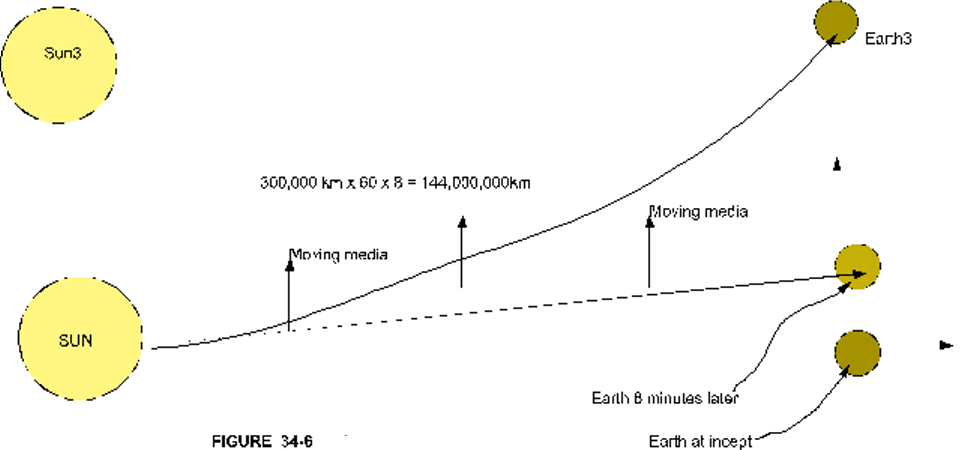
In this scenario assuming the earth and the media to move at the same
pace around the sun, then the light of the sun from its inception did in fact
strike the earth, and not as it would be in a straight line through space
to pass behind us. All this is only factual in the scenario that we depict or
design. For as we know the sun also
moves through space in its galactic turn at a speed yet greater than our
movement around the sun.
We
therefore in effect upon our earth are moving at a much greater speed through
space than what our yearly rotation around the sun accounts for. If therefore we
move our whole solar system up by eight minutes, the sun at Sun3,
and the earth at Earth3, the
line of light from its inception at the sun to the instant that it strikes the
earth - is by a curve.
All this is on the basis of placing space itself as a fixed entity. Which is not to convey that we know what space is, for although we may say or conceive it as just room, what in effect is room? We may set for ourselves the ideal of room as just room – but the same is also very elementary yet at the same time essential for us in our nature of being.
In our nature therefore it is not only convenient but also essential to assess and assume space as a fixed entity so that we may calculate all that moves therein to that prefix, or ideal if you will. Personally I am not satisfied with room as just room, or with movement as just movement. And while I know more in these things than I reveal, room is better left unto us as room, and movement as movement.
And now to backtrack to figure 34-4, how come WK, which is a directional change for a “greater” density - turns to the left and not to the right as it should? The principle as shown is not in error, it is simply that I used the upswing of the wavelet rather than the downswing. When therefore the same is drawn by the downswing utilizing line P to P1 the turn is to the right.
This therefore is not meant to
confuse us but rather to bring us to awareness remembering that sight deception
can lead to error.

And now by figure 34-7 we must admit that the eye is a most fantastic organ in that it can behold, or be instrumental to behold that whole sight all at once. Just stop and think how it may be that such an enormous number of light-waves projecting from every part of that large area can come into that tiny little ball called the eye.
It is of course not only due to the eye but the manner in which the wavelengths of light pass through the apparently transparent media called the air.
And one of the fundamental parts herein is that our
beholding is not limited to only reflected light so as it is or has commonly
been taught. But it is by any
wavelength in whatever manner it may connect upon our eye to thereby behold its
point of termination. And since the
molecules of air do not present a point of termination it therefore appears
transparent.
The diffusion then upon the roadbed that appears very much like water is by a termination in the air just above the road. This termination comes to us only at a certain angle as depicted by figure 34-8, where if the eye were at A or C they would be the negative with B the positive angle, or window as we might say.
This in all respect is like unto beholding the rainbow where there is a narrow window by which the bow might be seen. If per example we stood a hundred yards back or forwards of our first position we would again see the bow but at a different location.
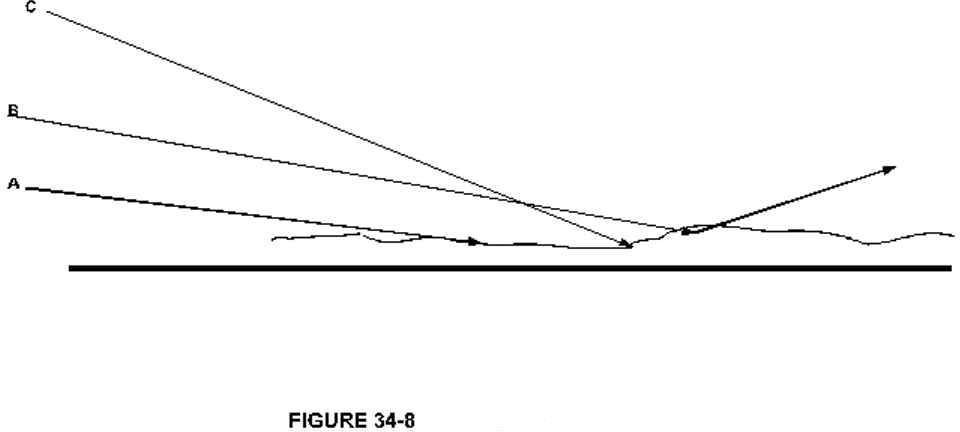
The same then is true for the haze upon the roadbed but in reverse.
With
the rainbow we are given an opening to see, while with the haze we are looking
through a window of termination. And just as with the rainbow it can not appear
in the same spot from any other angle, so with the termination it will not
appear at any other angle, but rather in this case the road in its normal view
will appear.
By
figure 34-9 the angle of refraction of the light is due to the
twofold angle at which the light strikes the change in media density.
Light’s angle A is the
overall angle of the light, with wave angle A and B
the individual wavelength. Since
therefore wave angle A is a
longer length to that of wave angle B,
the latter will refract at a greater angle, even though the light
angle is identical for both.
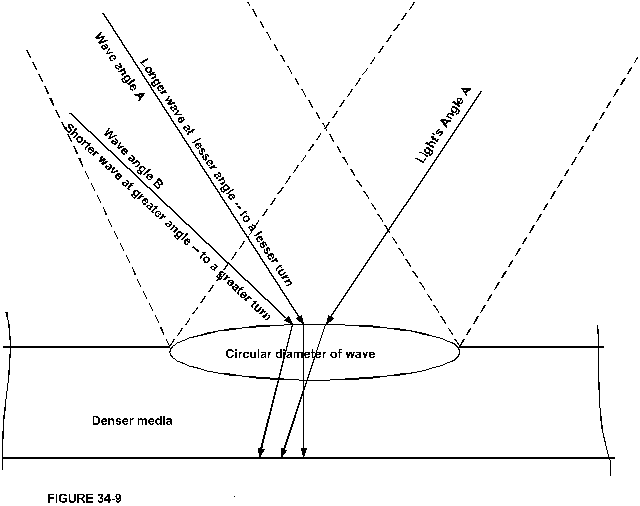
And now we are all a lot smarter than Einstein or the scientists of this earth in the fundamentals of things. And we need not be ashamed to grasp upon this.
I for one am not one to believe upon the Stork delivering babies, which is for children barely weaned from the breast. For here the parents conceiving that the truth is either too embarrassing or not suited for their young minds they fabricate something more comprehensive for them.
And
shall it be so in the mature world as well?
Light not having its susceptibility to the media, or being drawn by
gravitational force is no better than the story of the stork.
And with this I have but presented the beginning of what all we must
change in our conception of fundamentals in order to conceive and realize what
is factual in the nature of things.
There
are realms in which man is not to pass for the limits set unto him, and we do
well not to strain ourselves for it, a cliché that I am guilty of as well.
There is then within our limits more than sufficient to keep us occupied into
forever if you will, for the works of the Lord the Almighty Creator are as
marvelous to comprehend as they are endless in the number thereof.
And to acknowledge Him as the Founder thereof shall for a man be the beginning of wisdom. And for them that pronounce evolution - there is a grievous rod awaiting them.
The marvelous Property of “Velocity”
Certain metals will stretch and bend while others will break off. Some are stronger than others enduring greater or lesser pressure and/or temperature. Then there is stone in its many forms, bricks that crumble, and graphite so fine, while flint is quite hard, or diamond for that matter classified as stone.
Then again there is rubber that will stretch and return
to its original shape. With
all the substance in nature then there is what we call temperature to vary the
integrity of the substances. Paper
or wood will become ashes, and at lower temperatures rubber may become as hard
as stone, and/or as brittle as brick.
In all of these – as the term “temperature” suggests there is another term, namely “velocity” that is at the heart thereof. But the term “velocity” is wide ranging, wherefore we could for simplicity sake and to keep it elementary as well add the term “molecular to that of the velocity, to term it “molecular velocity”. This term for what I am associating it with now is a bit deceptive, it not being altogether what it may seem.
But my object here is to acquaint ourselves with
the reality of nature in its elementary terms, wherefore it shall be sufficient
to classify this velocity as the molecular velocity. Or we could say as I have
previously “change in relative movement”, or simply “relative movement”.
When you light a cigarette or start your fireplace what are you doing to turn the plant material into ashes? You are adding or increasing the velocity, (in and of the relative movement) the velocity of the movement that is associated with the molecular bond of that plant material by which the molecules will disassociate or disengage from one another. The lighter ones becoming gasses, the more substantial ones remaining as a brittle ash.
It may at first be difficult to conceive how all of nature is held together with nothing more than parts in movement by coordinate wherein velocity plays an important part, even as the interspacing by coordinate rather than by substance plays an equal important role. Yet so is nature and to appreciate its beauty so we must comprehend the same.
Just
think of the wool, the hairs of a sheep, and how all these short hairs become a
sweater to wear upon your shoulders if not the same is by interweaving and
coordinates. Or the flower of the
cotton plant to make for socks and breaches, or whatever clothing we may make of
cotton, which are examples of interspacing or weaving if you will that coincides
with coordinate.
The movement then of the coordinate, and that is in part the coordinate that effects or constitutes rubber – if the same is slowed down to a point below freezing, the molecules no longer adhere to one another.
For while at the higher movement - or velocity if you will - the
molecules continued to hold on to one other so as to stretch the same. The loss of velocity, of speed and coordinate made the
substance brittle to break apart easily.
Velocity thus does many things at its many different rates thereof. A slow movement around the turn requires little effort to go along in the turn. But at higher speeds we tend to stay in the straight trajectory.
A mixture of hydrogen and oxygen will happily stay apart as gasses, not adhering to one another, but with an increase in velocity to excite the components they will unite together to become a molecule of water.
Here then is a chain reaction that proceeds at great speed, for the one will excite the other, just as it is with gun powder, a rapid chain reaction that is seen by us as an explosion. The event however is the same as with iron rusting in the moist air, or with manure releasing methane gas, in which cases the chain reaction is very slow.
When therefore the chain reaction is very rapid it is seen as an explosion and paired with an increase in velocity, which in effect also is temperature in the adjoining media. The more rapid or the more fundamental these things take place the greater the effect as we have seen with atomic blasts.
It is still far reaching to come to a full or detailed understanding of how and why velocity is so at the heart of molecular change, and of molecular bonding. And while I have conferred upon in different ways in the past, I should have to go into a rather lengthy detailed definition thereof.
And if the same strikes me one day I might do so. As for now let it be sufficient for us to have an elementary understanding to at least come to the awareness of the coordinate factor of nature, of coordinate matter in motion, and movement to movement- wherein the “speed of” – and/or “rates of” play a fundamental role.
![]()